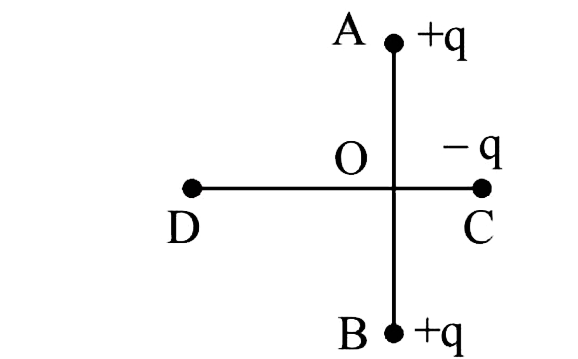Two fixed, equal, positive charges, each of magnitude 5×10−5 coul are located at points A and B separated by a distance of 6m. An equal and opposite charge moves towards them along the line COD, the perpendicular bisector of the line AB.
The moving charge, when it reaches the point C at a distance of 4m from O, has a kinetic energy of 4 joules. Calculate the distance of the farthest point D which the negative charge will reach before returning towards C.

Step by step video & image solution for Two fixed, equal, positive charges, each of magnitude 5xx10^-5 coul are located at points A and B separated by a distance of 6m. An equal and opposite charge moves towards them along the line COD, the perpendicular bisector of the line AB. The moving charge, when it reaches the point C at a distance of 4m from O, has a kinetic energy of 4 joules. Calculate the distance of the farthest point D which the negative charge will reach before returning towards C. by Physics experts to help you in doubts & scoring excellent marks in Class 12 exams.
Topper's Solved these Questions
- BOOK - SL ARORACHAPTER - ELECTRIC POTENTIAL AND ELECTRIC FLUXEXERCISE - Problems for self practive61videos
ELECTRIC POTENTIAL AND ELECTRIC FLUX
- BOOK - SL ARORACHAPTER - ELECTRIC POTENTIAL AND ELECTRIC FLUXEXERCISE - Problems for self practive61videos
ELECTRIC POTENTIAL AND ELECTRIC FLUX
- BOOK - SL ARORACHAPTER - CURRENT ELECTRICITYEXERCISE - Problems For Self101videos
CURRENT ELECTRICITY
- BOOK - SL ARORACHAPTER - ELECTRICAL INSTRUMENTSEXERCISE - Problem for self practice81videos
ELECTRICAL INSTRUMENTS
Similar Questions
Knowledge Check
- Question 1 - Select One
Two equal and opposite charges separated by a finite distance is
Aelectric dipoleBelectric torqueCelectric dipole momentDnone of these - Question 2 - Select One
At any point on the right bisector of line joining two equal and opposite charges
Athe electric field is zeroBthe electric potential is zeroCthe electric potential decreases with increasing distance from centreDthe electric field is perpendicular to the line joining the charges - Question 3 - Select One or More
Two point charges Q and −Q/4 are separated by a distance X. Then
 .Apotential is zero at a point on the axis which is x/3 on the right side of the cahrge −q/4Bpotential is zero at a point on the axis which is x/5 on the left side fo the charge −Q/4Celectric field is zero at a point on the axis which is at a distance x on the right side fo the charge −Q/4Dthere exist two points on the axis where electric field is zero.
.Apotential is zero at a point on the axis which is x/3 on the right side of the cahrge −q/4Bpotential is zero at a point on the axis which is x/5 on the left side fo the charge −Q/4Celectric field is zero at a point on the axis which is at a distance x on the right side fo the charge −Q/4Dthere exist two points on the axis where electric field is zero.
Two charges 10μCand−10μC are placed at points A.andB separated by a distance of 10 cm. Find the electric field at a point P on the perpendicular bisector of AB at. a distance of 12 cm from its middle point.
View SolutionTwo point charges of 1μCand−1μC are separated by a distance of 100 Å. A point P is at a distance of 10 cm from the midpoint and on the perpendicular bisector of the line joining the two charges. The electric field at P will be
View SolutionTwo equal charges q of opposite sign are separated by a small distance 2a,The electric intensity E at a point on the perpendicular bisector of theline joining the two charges at a very large distance r form the line is
View SolutionTwo point charges of different magnitudes and of opposite signs are separated by some distance. There can be.
View SolutionThe two point charges 4μC and 1μC are separated by a distance of 2 m in air. Find the point on the line joining the charges at which net electric field of the system is zero.
View Solution

